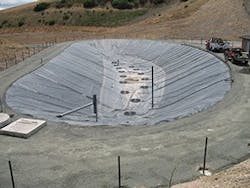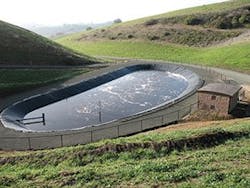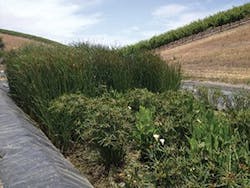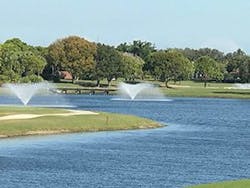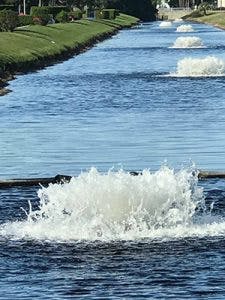People who love fine wine often pride themselves on paying close attention to the subtle differences between each sip. Some can discover flavors so nuanced that choosing among favorites has evolved into an art form, with books, movies, magazines, and talk shows dedicated to exploring and enhancing the experience. With drinkers often seeking something beyond what can be perceived via the five senses, winemakers are ever seeking new ways to distinguish their offerings. One way to make a difference is by being good stewards of the environment.
“Customers increasingly like to be environmentally friendly, so we decided to do whatever it would take to be LEED certified,” says Tom Bower, president of Bower Engineering. His firm designed a state-of-the-art winery for Niner Wines in Paso Robles, CA. “The owners are people who want to do the right thing for the environment. And once you start going for LEED certification, there is a certain marketability in that.” However, he says, “When you get to a product like wine, some consumers don’t care where it comes from or how you farmed it, whether you’re environmentally friendly or not, but there is a certain level of people that really care about that. The company has put a lot of time and effort into growing grapes through sustainable vineyard practices, and they wanted to continue that into the winemaking area by conserving water.”
Diffusers on pond bottom
While a high degree of care goes into a vintner’s craft, even after months, years, or even decades of labor, some of the finest wines are not yet ready to sip directly. The best wines will often be a bit short on one important ingredient that the winemaker dare not add before its time: oxygen.
Connoisseurs refer to the process of uncorking the bottle and letting it stand for an interlude before drinking as “letting the wine breathe.” As the wine is exposed to the normal composition of the atmosphere under normal pressure, the gasses in the air and wine approach equilibrium. Oxygen molecules nestle into place, nudging their way in, to saturate the wine according to the principles set forth in Henry’s Law of gases. Real experts take things one step further; rather than passively letting the wine stand for a few moments, they pour their prized beverage first into a decanter to further expose it to the air before serving. This allows the air to mix deeply with the wine.
Even more than oxygen, on the way to the sparkling crystal and whispered comments on the wine’s subtlety and texture, a lot of water gets used up. Although Bower notes that water is never added to wine, water is essential to winery operations in many other respects, and in some of the major wine-growing regions of California, water is an increasingly scarce commodity. To stretch the limited resource, Niner Wine Estates makes liberal use of aeration: mixing water and oxygen to get the greatest utility from both. Bower knew of EP Aeration as a local company in the Paso Robles area. “I had heard they had been doing work with ponds at golf courses, to keep them from stagnating. So when we were designing the winery, I called them up and found out what they had.”
Using As Little Water As Possible
The task was to build a winery capable of producing 50,000 cases per year in a sustainable manner. Situated on 160 acres cut out from of the Niner’s total holdings of more than 300 acres, it includes three buildings: a very large 65,000-square-foot wine production facility, a small craft winery for making specialized products, and a 10,000-square-foot hospitality center for wine tastings and a restaurant. Included in the footprint is the winery crush pad, where grapes are transported and prepared for winemaking. “The goal of the operation was to be environmentally friendly and to consume as little water as possible,” says Bower.
Describing the stormwater system, he notes, “Most of the water falls on the vineyards and soaks into the ground. We capture all the rainfall that falls on the roof and the crush pad. Stormwater from parking areas is not captured but is drained to storm drains and conveyed off the property.”
Making wine uses large volumes of water, “mainly for cleaning and maintaining the process,” says Bower. He says this amounts to 5 or 10 gallons of water for every case of wine produced, “which is a lot of water.” All of the water collected at Niner Winery goes through a multi-stage treatment process after use, to eventually reemerge as irrigation water for the vines.
Bower describes the process. “When it’s first collected, the grape juice and wastewater mix is very acidic. We neutralize the pH by adding ammonia. Then it’s pumped through a screening system to pull out all the grape seeds and skins. Then it is accumulated into a facultative pond that treats the water. From there it flows to a constructed wetland that is filled with plants that you would find growing in a marsh, like reeds, to further polish the water. After that, it goes to large holding pond for use when we need it for the vineyards” or for fire suppression, he says.
The facultative pond holds about 300,000 gallons and is aerated with fine bubble aeration. “Depending on how fast we’re processing, it stays there for many days while the aeration breaks down the organic material and purifies the water,” he explains.
Bower says he selected fine bubble aeration using Air Diffusion Systems (ADS) aeration diffusers, installed by EP Aeration. According to Bower, the traditional way vineyards have dealt with process wastewater has been using surface paddle aeration driven by large motors with paddle wheels. This uses a lot more energy, and by splashing up surface water to get air into it, it gives up a lot more water to evaporation. “With the fine bubble aeration, you’re providing fine bubbles at the bottom of the pond, and it bubbles up through and provides good aeration by that method.”
Richard Dennis, president of EP Aeration, says the system functions by creating columns of bubbles that push water to the surface, where it comes into contact with air, enabling the water to absorb oxygen. By constantly pushing the water around as they rise, the bubbles help mix the oxygen-rich water throughout the targeted treatment area without wasting water by spraying it into the air. This serves two of Niner Winery’s goals, notes Bower. “We’re trying to save every drop of water, so our evaporation rate is very low, and our energy use to break down the organic material in the water is very low.”
According to Dennis, the energy savings qualified the owner for a rebate equating to approximately 10% of the capital cost of the aeration system and led to an annual energy cost savings of about $17,000 when compared to the surface aerators that have traditionally been used in the winemaking industry. Furthermore, it is powered by Niner Winery’s own solar power system, which fulfills all of the power requirements onsite “with one of the larger solar panel installations for a winery in California. It’s a real commitment to sustainability,” says Bower.
Meeting the Numbers
“We monitor oxygen levels at least weekly; if it gets too low, the facultative pond will get an odor to it. If we meet that number, we are assured of an odor-free pond. If our lab technician sees the oxygen level getting too low, we increase the amount of aeration we apply by regulating the number of diffusers that are in operation at one time. It’s a good natural way to treat wastewater, so we’re real happy with it,” says Bower.
Onshore blowers maintain a pressure of about 5 psi with submerged hoses providing air to the diffusers. Maintenance is very simple, says Bower. “We do oil changes and filter changes for the air blowers. About every two years, we clean the aeration disks with an acid solution to maintain the slits in the tubing that produce the fine bubbles.”
He adds, “Once you have a lined pond, it is a fairly simple operation to install the three air blowers to feed the 14 disks that EP Aerators recommended, based on the winery’s water-quality criteria. We calculated the energy that was required for this would be about one-third what it would take for surface aeration. It’s very energy efficient. That’s one of the reasons we went for it; there’s little evaporation and it’s the most energy efficient way of aerating the water.”
The nature-based process fits in well with the owners’ appreciation for the environment. “We have a lot of natural wildlife around. We keep the larger animals out—you know, deer raise hell with a vineyard—so we protect the vineyard with a fence. But other than that, the vineyard is full of birds, rabbits, gophers, all kinds of wildlife. Some of them we like, some of them we don’t; some of them tear up the vines, of course.” However, he notes, “It’s a very natural looking area. We grow very specialized cover crops between the rows—specially selected plants that provide good nutrients for the soil.”
He says, “We are extremely happy with the way we went. Most of the wineries in the area use surface paddle aeration. They don’t reuse their water; they don’t treat it well enough that they can put it back into their vineyard. We took the extra step.” Treating process water to the level required for reuse takes substantial financial commitment, but Bower explains, “We’re in an area where water is scarce, so I think of it as something we’re doing for the long term.”
North Palm Beach County, FL
Removing a Hazard
Jon Iles is one of several operations managers for Northern Palm Beach County Improvement District (NPBCID). Each operations manager deals with specific responsibilities for infrastructure management, maintenance, and improvement. Iles runs and manages the aeration program implemented to help maintain water quality at the many lakes that adorn the residential development sites under NPBCID jurisdiction. As a Florida Section 298 special taxing district agency, NPBCID has a mandate to float bonds for infrastructure improvements deemed to benefit the county and its residents, to be paid by tax assessments on the designated property units benefiting from those improvements.
As Iles explains, developers of large land parcels in the legislative boundary can apply to NPBCID and float bonds for infrastructure development such as roads, drainage, lights, sidewalks, guardhouses, and sewer and water infrastructure. These improvements, financed through bonds, allow the residents, over time, to pay the bonds back, while NPBCID is responsible for maintenance and management of the items specified by contract.
Iles says NPBCID wears a variety of hats depending on the needs and desires of the community. “We don’t do the same things in every development. In some places we have pump stations, in some places we have operable gate structures, so when it’s pouring down rain, our main function is surface water management, following plans that are approved by South Florida Water Management. In others, we have to control the aquatic vegetation, and we have a different manager for that. Aeration provides one tool among many for the management of lake water systems.”
Iles describes the area as home to a number of golfing and luxury residential communities. For all their appeal, he says, the lakes in golf country “are all man-made. It’s not like out West, in Colorado, where you get snowmelt and the introduction of fresh crystalline water into a lake system.” Though mostly artificial, the drainage systems are designed to provide the homes with waterfront vistas and to serve as water hazards on the golf courses, which are one of the big draws for homebuyers in the area. But the water is supplied by rainfall, augmented by reused water supplied by local utilities for irrigation.
From an infrastructure perspective, he says, “The lakes exist for capture and retention of stormwater, to store it until it meets a certain water quality. In most places in south Florida you have to retain the first inch of rainfall, and that gives time for the sediments or particulates or common pollutants to settle out of the water before it’s moved downstream.”
According to Iles, the water-quality challenge is that “all of the lake systems inside a community are interconnected, and there is no introduction of fresh water other than rainfall.” He explains that it’s “as if you were to take a cup of water and not introduce any type of clean water to it; it just becomes stagnant.”
Sometimes in south Florida, he notes, weather patterns make matters worse. The lakes, if they are deep enough, can stratify. The colder, deeper strata usually hold more diffused oxygen than the warmer upper layers. “But sometimes you get a temperature inversion, and when the lake flips over, the cold from the bottom comes up and loses its diffused oxygen; the dissolved oxygen for the entire lake can go almost to zero,” he says.
According to Iles, most bodies of water in south Florida, “on their own, without any type of aeration, probably exist at maybe, three or four parts per million diffused oxygen.” By contrast, he says, rainbow trout, which do not inhabit south Florida, “would require 12 parts per million dissolved oxygen to exist.” The aeration program introduces more diffused oxygen into the water body.
While trout fishing might be out of the question in south Florida, for perhaps a slew of reasons, healthy water is an essential requirement. Iles relies on Otterbine-Barebo aerators as his number-one tool to keep the district’s lakes up to par.
Informal tests of the aerators’ efficacy were performed at BallenIsles, a gated community that NPBCID serves. “They have quite a few of our aerators,” says Dave Blackburn, vice president of Future Horizons, the firm that installs and manages aeration systems for NPBCID. He explains an experiment conducted on side-by-side lakes on a country club golf course that was accepting runoff in Palm Beach Gardens. Before the test, he says, the two aerator units had been in place for about two years and were running efficiently. “We went in and turned off the unit serving one of the lakes.” The parts-per-million oxygen content in the lake whose aerator had been turned off “went to zero within about three days. The other maintained its oxygen efficiency around six or seven parts per million,” says Blackburn. “When we turned the other one back on, within a 24-hour period it was back up to around three or four parts per million, and within 48 hours it was up to its normal oxygen rates of around five to six parts per million.”
In addition to proving the efficiency of the aeration for improving water quality, says Iles, the test provided “some kind of hard numbers, should the residents ever ask what does it actually do for water quality.”
Iles describes a scenario at a lake several miles away that was supplied with recycled water to be used for irrigation at BallenIsles. “This one lake was so bad that you couldn’t go by the subdivision without smelling it. It just stunk. There was blue-green algae in the lake system.” He believes it could have been indicative of fecal coliform contamination in the water. However, he says, “We don’t sample water or test it, but this type of algae just smells horrendously bad.
“One of the homeowners associations around that pond approached us, and we said as one of the tools to get rid of that stink, we could put an aerator in the cove.” The homeowners association approved the proposal and had Future Horizons install the aerator, and “within two days that stink was gone,” says Iles. By chance, sometime later, the aerator broke down, which Iles said is happens from time to time—“It’s a mechanical thing, and the motor can go out.”
He continues, “It was in the summertime. It was very hot and muggy, and within 48 hours after the breakdown, that stink came back. Fortunately, we have a contract with Future Horizons, and Dave Blackburn provides us excellent service. He pulled the unit out of the water, took it to his shop, put a new motor on it and whatever other parts were required, got it back in there running, and the odor went away,” demonstrating in a real-life circumstance the power of dissolved oxygen.
Don’t Stop for the Fishes
Mechanical aeration is effective and quite necessary, says Iles. “When the sun goes down, photosynthesis stops, but the fish don’t stop breathing, nor do the turtles or any other type of aquatic life; ideally we want [the aerators] running 24 hours a day.” If that is not feasible, he notes, “They’re best to be run at nighttime. In all of the lakes, without the aerators, the dissolved oxygen drops off significantly.”
Future Horizons has been the only company NPBCID has used for the aerator program. Blackburn says his company has been serving the district for more than three decades. Iles notes that the program is still growing: “In 2002, there were slightly over 200 aerators, and there are over 460 of them now.” He has plans to provide aeration to at least five more communities in the coming years.
Through Future Horizons, he says, Otterbine-Barebo offers a host of different equipment. However, Iles has elected to incorporate only three aerator models for use in NPBCID’s aerator program. These are Otterbine’s Gemini, Sunburst, and High Volume Aerators. From Iles’ perspective, it doesn’t make sense to use funds collected by assessments just “for pretty.” He explains: “The more you try to alter the discharge pattern, generally the fewer gallons per minute the unit is flowing, and the less water you’re moving per unit time, the less efficient the unit is. It’s not diffusing as much oxygen into the water. Our whole purpose in the aerator program is to try to introduce as much diffused oxygen as we can, because the more of that you have, the healthier the water body is.”
While the Gemini and the Sunburst aerators have discharge restrictors that create an aesthetic conical spray pattern, Otterbine’s most efficient unit, the High Volume Aerator, “looks roughly like a boat prop turned vertically in the water,” says Iles. Its discharge pattern “simply looks like a water main that is ruptured. It just sits there like a cauldron boiling at the surface of the water.” Nonetheless, says Iles, “It moves the most water per unit of time in gallons per minute,” operating on the same 5-horsepower motor as the Gemini and Sunburst. “I try to be a good steward of the public money, so I took the three most efficient units that they have and said that if we have to assess people to buy the equipment, we’re not going to have a decorative fountain, we’re going to have an aerator. That way, we’re putting the most diffused oxygen we can back in the water per given unit of horsepower.”
It’s the oxygen that people want most of all, he believes. “We get all sorts of phone calls saying, ‘Thank you for putting it in. We’ve been waiting for this a long time.’ We also get just the opposite—‘I’ve been living here 24 years, and if anybody had told me that was going to be put in I never would have bought the house.’ We have people who love them and people who hate them.” But Iles says that in virtually every case, after six months in operation, even the staunchest opponents “come around and love it.” He reflects, “Anything that’s ever been put in the water—if you give it six months, they would like to kill you if you proposed to take it out. It’s a very successful program for a number of reasons.”
He notes, “The largest complaint we receive is that some people don’t like the noise.” There are two types of noise. First, the ambient sound created by throwing water up into the air and letting it splash back to surface. “There’s the mechanical noise of the water going through the throat of the diffuser and the motor hum,” which varies depending on the model, the horsepower, and the prop, he says. But it can all be managed: “We work with the residents through their representative homeowners associations. To address noise concerns for the association, we’ll try to relocate it farther from the home. Because one person really likes it that doesn’t mean their next-door neighbor will.”
Concerns over sound can also be addressed by “altering the prop size or hours of operation. If we want to reduce the size of the prop, we can put a 3-horsepower prop on a 5-horsepower motor. The motor doesn’t care; it’s spinning at the same RPM. Just because of the pitch of the prop, it’s going to throw less water. We can manipulate the hours that the aerator runs, we can manipulate the location, and we can manipulate the size of the prop. By downsizing, you can put a 3-horsepower prop on a 5-horsepower motor, or a 2-horsepower prop on a 3-horsepower motor. You can always downsize the prop.”
Choosing a new location is another possible solution. “Moving it is easy. They’re anchored by rope and block. Once we agree to make a modification, we can take care of that within a 24-hour time period.” Only once has the program had to remove a unit entirely—and that doesn’t really count, says Iles. It was simply a case where a unit had been installed by mistake due to a communications mix-up. Summing up the success of the program, he says, “Out of 460 put in, 460 remain.”
He adds, “We always work with the elected representatives of the community. They adjust the run hours. They approve the proposed installation location before we start. The best thing we have going at NPBCID is that we have wonderful communications with our constituents through their community representatives.”
The aerators are hardy devices, he says. “If anything goes wrong, we wait for the residents, generally, to call us and Dave will go out and respond. If he can’t clear it from the shore control cabinet, he’ll go out in a boat. It could just be submerged aquatic vegetation such as algae that gets stuck in the discharge chamber. Then they put it back in the lake. Unfortunately, sometimes it is a turtle or a plastic bag or some other debris. There are protective elements on the aerator, there are thermals that trip, there are breakers that trip to preserve the overall longevity of the motor. Whether it’s a shore component or a water component of the system, Future Horizons is very good about responding and getting these things up and running. They are required by our contract to once a month visually and physically inspect every aerator that we own. Once a year, they have to pull each one out of the water, take them to their shop, break them all down, put in new oil new gaskets, and give them the once-over, and that extends the warranty period five years for us. It’s like going to your doctor and getting a good physical. We get exceptional service.”
Nutrients and Nutrition
Along with providing drainage and stormwater management, urban lakes serve many functions, some of which might be surprising. For example, DeAna Vitela-Hayashi, president of AquaBio Environmental Technologies, an aquatic bioremediation firm in Southern California, says the lakes in low-income area parks often serve as more than just a place to relax and hang out. According to Vitela-Hayashi, Los Angeles’ stocked lakes in low-income areas are extremely important to the community as source of food and not just recreation. She notes, “There are many families that, toward the end of the month, survive off the fish they catch in those urban lakes until the next check comes in.”
One of these lakes in South Central Los Angeles had been situated on a rehabilitated and restored industrial site. “When they lined the lake, they thought it would be sufficient; however, as the lake aged and the liners broke, some of the pollutants began to seep into the lake,” says Vitela-Hayashi. Combined with insufficient aeration or no aeration, water quality in the lake began to deteriorate. “By adding consistent aeration and a management program that included bio-augmentation, the lake turned around. We saw a change within six months or less.”
She notes, “Because it still has incoming pollutants coming from the groundwater, the lake still has ongoing problems, but we’ve been able to remediate everything else to a point of acceptable levels way below what EPA designates as an impaired body of water.”
She says, “I deal with urban watersheds and urban lakes, and when I first get a lot of those projects their nutrient levels can be as high as you would see in a waste treatment facility.” In some cases, the high levels of nutrients can be attributed to recycled water use. “Diffusion air using smaller bubble sizes makes it a lot easier to work with.”
Aeration Plus
According to Vitela-Hayashi, AquaBio combines bio-augmentation, using specially selected microbes with mechanical oxygen diffusion, to purify the water naturally. “The more oxygen we give to the microbes the better.” She explains, “One of the lakes in South Central Los Angeles had issues with cyanobacteria. We have a formulation that can out compete it. And by the addition of our microbes and the aeration, we’re able to knock that out.”
The key, she says, is the bubble size. “It is micron size and therefore it holds longer in the water column versus the large bubbler; those are very inefficient. Oxygen is very important, whether you’re doing bio-stimulation—that’s using the naturally occurring microbes onsite and oxygen—or bio-augmentation by adding microbes to handle what you’re trying to get rid of.”
To serve its Southern California clients, AquaBio distributes and installs diffusers from either Vertex or Air Diffusion Systems, “depending on how much organics are on the site.” For sites such as waste treatment facilities, Vitela-Hayashi prefers very heavy-duty aeration diffusers such as those manufactured by ADS. “If it’s a lake, I can use a typical lake diffusion type,” for which she says she turns to Vertex. “They have a compressor on shore and weighted aeration lines that go from the compressor to the diffusion disks, and those disks are weighted down by a box with rocks.” Based on the micron size of the aeration, she says, Vertex equipment is ideal for aerating lakes that are “at least four feet in depth.” These systems “run on anything from one-half horsepower to one horsepower,” and the micron-size bubbles they generate, rising from the bottom, reside in the water column for the longest duration possible, providing maximal oxygen diffusion, she explains.
Aeration can provide more than just water-quality management. Vitela-Hayashi has deployed ADS systems in temporary aquatic wildlife rescue and relocation projects, operating the aerators while lakes that provided wildlife habitat were being drawn down for construction or management purposes. She said the ADS systems can provide sufficient aeration “so that the animals in the lake don’t die.” She has had success operating diffusers in lake water as shallow as 2 feet in depth, allowing rescue teams the opportunity to capture the animals and transport them from the lakes to safety, following the recommendations of fish and wildlife agencies. “It’s nice to have a large system like that where we can lift it and move it and put it in where it’s needed.”

